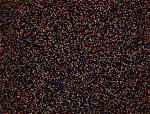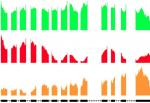Overview of Course Modules
 |
What Is Genomics? Why Do Genomics?This module begins with a video introducing the genome and how it is studied by researchers. Three short videos highlight applications of genomics to food, biodiversity and healthcare.
Discussion questions and resources relevant to each section are listed below the videos.
|
 |
Tour of the GenomeThis module describes genome structure and how it relates to function. It uses videos to introduce and visually represent the human genome. In small groups, students investigate how problems with genome structure can result in genetic diseases.
|
 |
DNA SequencingThis module explains why DNA sequencing information is important for the biological sciences. It provides a brief description of the technical challenges of DNA sequencing. Students learn the basic principles of sequencing-by-synthesis, which is a widely used next-generation sequencing (NGS) technology. Students will do an online activity that simulates sequencing strings of DNA.
|
 |
RNA SequencingThis module introduces RNA measurement and sequencing as a technique for learning about cell and tissue functionality.
Learning Objectives:
Explore several methods for measuring RNA.
Develop a general understanding of how to perform RNA sequencing experiments.
|
 |
What Makes a Nerve Cell Different from a Skin Cell?The same genome is in every cell of your body. Yet different cells in different parts of your body look and act very differently. Watch a video that describes one way a bioinformatician could approach the question: How does the same genome produce different types of cells? The activity explores several databases used by bioinformaticians and other scientists for their research.
|
 |
Bioinformatics: What? Why? Who?What is bioinformatics? Why is it important? Who does bioinformatics? This module places bioinformatics and the researchers who are experts in bioinformatics into a larger context. The activity explores the concept of an “algorithm,” which is a basic tool used by bioinformaticians.
|
 |
RNA Sequencing: Up Close with the DataRNA plays an important role in biological systems as the intermediary between DNA and proteins. By measuring the RNA in a cell or tissue, we learn about the cell’s/tissue’s function. RNA sequencing (RNA-seq) is a relatively new technology that allows us to measure RNA in a sample with a high degree of accuracy. In this module, we will discuss types of data generated by RNA-seq experiments.
Learning Objectives:
List the different types of information that can be gained from RNA-seq experiments.
Develop a general understanding of how RNA sequencing data are analyzed.
Explore some of the challenges associated with analyzing RNA-seq data.
|
 |
Browsing GenomesThe Browsing Genomes module uses the parasite Toxoplasma as an example to show how anyone who has internet access can use experimental results from scientists. Making data publicly available through databases like ToxoDB helps science move forward much more quickly than what would be possible without them. Like libraries, databases store and organize information in a structured way that allows users to find and use existing information as well as contribute new research findings for others to use.
Browsing Genomes gives you a tour of the ToxoDB database and a tool to explore its genome-related information. Then, it leads you through an activity using real data from an experiment that studied gene expression in different life stages of the Toxoplasma parasite.
|


 Discovering the Genome
Discovering the Genome